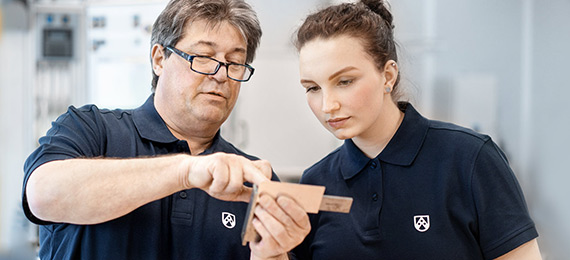Resistance to aggressive chemicals
Special material for electrolytic cells
Should all objects in your everyday life containing zinc be absent, you would be missing quite a good deal. Zinc confronts us everywhere: In water taps, in creams, trouser buttons or kitchen machines. One process for obtaining this multi-applicable metal is zinc electrolysis – an electro-chemical process, in which aggressive chemicals are used. This is why the chemical plants need a particularly resistant protective shell.
A customer of Röchling of long years` standing, STEULER-KCH GmbH, Siershahn, is known, amongst other fields, as a plant builder and supplier of surface protective systems for chemical facilities, and successfully implements semi-finished products made of thermoplastics from Röchling. A special material was necessary for lining concrete basins in a zinc electrolysis plant due to the chemicals used.
Zinc being produced
Zinc electrolysis is an electro-chemical process that takes place in so-called electrolytic cells – here the concrete basin. An electric current is passed through zinc sulphate dissolved in sulphuric acid by means of electrodes embedded in the cells, so that an electro-chemical process is triggered, leading to metallic zinc being produced which is deposited on the cathodes of the electrodes. The cathodes are freed from the deposited zinc on strippers.
Chemical-resistant plastics necessary
For technical reasons, further aggressive chemicals are added in the process. The electrolytic cells must therefore be lined with particularly chemical-resistant plastics. Here, selection of the right material is of decisive importance.
Stress crack formation and oxidative attack
In order to monitor the influence of the chemicals used on the plastics made available here, Röchling - in close co-operation with Steuler-KCH – embedded material samples in the electrolytic baths for a protracted period of time. Subsequently, it was examined how the chemicals had impacted on the samples. In particular, the emerging stress crack formation and embrittlement through an oxidative attack were important indicators for selection of the right material.

Standard plastics not suitable
Standard products for thermoplastic linings do not offer adequately high resistance to these two effects. While it is true that, for example, raw materials, Type PE 100-RC – RC standing for resistant to crack, have outstanding stress cracking resistance of over 8760 h according to the Full Notch Creep Test, they do not, however, have any greater resistance to oxidative attack compared to a conventional PE 100.
Special material in demand
Based on the results of this investigation, Röchling developed a special formulation: A material based on a PE 100-RC with an extra additive package. This new material fulfils, on a sustained basis, the high requirements made in the zinc electrolysis plant, thus contributing to the plant’s long service life. “By means of the close co-operation with Röchling, we were able to work out a solution for our problem,” Steuler draws a positive conclusion.
Special lining technology
As early as in 1970, STEULER had developed the thermoplastic lining BEKAPLAST™, which is also used for lining concrete basins. The distinctive features of the BEKAPLAST™ system are the special, conically broadening anchor knops on the back of the sheets made of thermoplastics, which establish a mechanical connection with the concrete.





